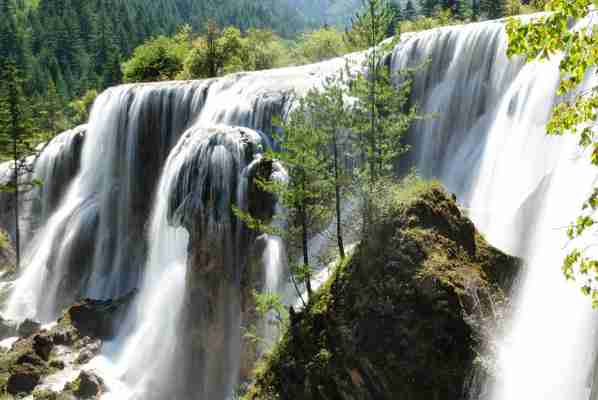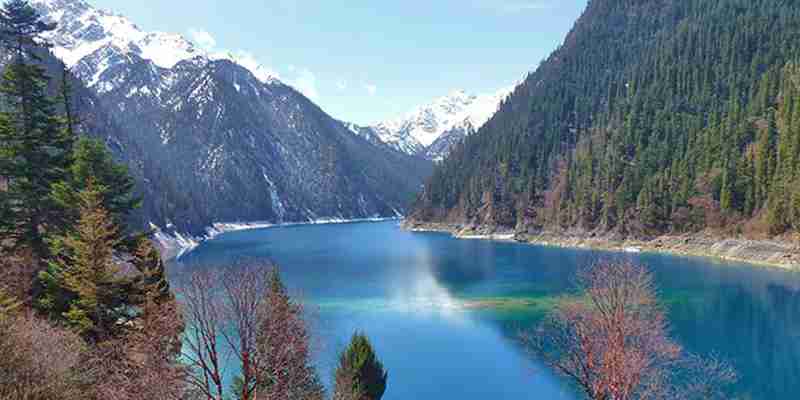Jiuzhaigou — Colorful Fairyland with Picturesque Waterscapes
Jiuzhaigou — Colorful Fairyland with Picturesque Waterscapes

Beautiful Lake and Forests in the Jiuzhaigou Valley Scenic and Historic Interest Area of Sichuan Province, Photo by Leonoyes.
What Are Jiuzhaigou and Jiuzhaigou Valley Scenic and Historic Interest Areas?
Jiuzhaigou County, originally named Nanping and Yangtong, was included in the territory of the Han Dynasty over 2000 years ago.
In 1998, it changed to Jiuzhaigou, named after the stunning Jiuzhaigou Valley Scenic and Historic Interest Area located inside.
The Jiuzhaigou Valley Scenic and Historic Interest Area, a UNESCO World Heritage Site, is famous for stunning, colorful waterscapes, diverse ecosystems, picturesque terraces, and impressive karst views.
Facts About Jiuzhaigou Valley Scenic And Historic Interest Area
The Jiuzhaigou Valley Scenic and Historic Interest Area stretches over more than 72,000 hectares (72,000,000,000 sq. m) and is a part of the Minshan Mountains.

It has superb landscapes and is on the edge of the Qinghai-Tibetan Plateau and the northern part of Sichuan province. It is a reserve of natural heritage with several mountains as well as an alpine and coniferous forest.
Geology, Geography, & Climate
Its fairyland landscape consists of high-altitude karsts that happened due to hydrological, glacial, and tectonic activity. It lies on the diverging belt between the Yangtze plate and the Qinghai-Tibet plate. Earthquakes are also responsible for shaping this fairyland landscape.
It lies in Jiuzhaigou County, previously known as Nanping County. It is based in the Sichuan province, near the border of Gansu. The location has buffer zones covering 231.661 sq. mi (600 sq. km), and at the Zechawa Gully top, Mount Ganzigonggai ranges from 14,954 ft. to 15,629.9 ft. (4,558 m-4,764m).
When it comes to the climate of the Sichuan province, it experiences a temperate to subtropical monsoon. The mean annual temperature hovers around 46.08 degrees F (7.8 degrees C); in July, it goes up to 62.24 degrees F (16.8 degrees C), and in January, it is -38.66 degrees F (-3.7 degrees C). This natural heritage receives an annual rainfall of 29.96 in (76.1 cm), whereas the cloud forest receives 39.37 in (100 cm). Between May and October, it receives around 80% of the rainfall.
History, Population, & Tourism
The area gained its name from the nine Tibetan settlements present aside from its length. Many Qiang and Tibetan residents inhabited the remote region, but up until 1975, not many people were aware of this place. From 1979, people started to access this area for wood. This led to the government of China banning logging activity and announcing Jiuzhaigou Valley as a national park. It happened in 1982, but the site was officially opened for mass tourism in 1984 by the Administrative Bureau.
Seven out of nine villages present here are still populated. Shuzheng, Heye, and Zechawa are the main agglomerations that tourists can access easily. In 2003, 112 families resided in these areas comprised of 1,000 members. Agriculture is no longer permitted here, which means that the residents rely on local government subsidies and tourism for survival. They travel from the southeast of the main Shuzheng gully to reach the Zharu valley and visit other places.
This valley is a popular tourist destination for those visiting Jiuzhaigou. They can enjoy camping, hiking, multiple-day walks, and more here. Its natural heritage is comprised of limestone terraces, coniferous forest, fairyland landscape, and many more.
Famous Valleys
Three valleys give this place its Y shape. The Zechawa and Rize valleys flow from the south and join at the center where another valley, the Shuzheng, flows. Check out a brief summary of the three different valleys here:
Zehava Valley: This valley is towards the south-eastern side of Jiuzhaigou stretches for 59,055.11 ft (18,000 m). While traveling downhill, you can enjoy the highest, largest, crescent-shaped lake, Long Lake.
Rize Valley: The Rize Valley is 59,055.11 ft (18,000 m) long and is the southwestern branch of Jiuzhaigou. People usually visit this first since it has the largest variety of easily accessible spots. While going down the hill, tourists will come across different great scenic value spots. The first one is the limestone terraces preserved in ancient woodland, then comes the Primeval Forest, which includes the blade-shaped rock, surrounding cliffs, mountains, etc.
Shuzheng Valley: It is located in the northern part of Jiuzhaigou and is located at the Y intersection. The great scenic value of the place is what you will love the most. You can explore Nuorilang Falls at the junction, which stretches 1,049.87 ft (320 m) wide and 98.42 ft (30 m) in height.
A World Heritage Site
The place was declared as World Heritage Site in 1992. After that, in 1997, it was declared as a World Biosphere Reserve. UNESCO has inscribed it as a reserve for endangered plant and animal species, like the giant panda. As a result, this place is a natural museum used for karst research and hydrology.
Other Miscellaneous Facts
Jiuzhaigou is a place with narrowed forested lakes, mountains, and three valleys. Several miscellaneous facts about this place are:
Wildlife is a part of the forests and includes over 10 vertebrate species, among other living organisms. Some endangered species are the black-neck crane, the giant panda, the red-belly golden pheasant, white-lip deer, forest musk deer, lovebirds, the swan, etc.
Giant pandas are the most spotted in this place, and the reason is because of the flowering of bamboo trees. Most importantly, these forests need to be protected from forest pests to protect the endangered plant, bird, and animal species.
The giant panda, which is highly protected, is also a symbol of WWF. The ecosystem of this place is comprised of highland systems with many mountains. People who love mixed mountain, flora, and fauna can explore this place.
FAQs
Why is Jiuzhaigou special?
A: This place is the transition area between the Qinghai-Tibet plateau and the Sichuan Basin, which is what makes this place special.
What is Jiuzhaigou Valley known for?
A: This place is known for the Min Mountains. It also has limestone terraces, colorful lakes, multi-level waterfalls, and snow-capped peaks.
Is Jiuzhaigou Valley man-made?
A: No, it is not man-made; earthquakes have shaped this place.
How was Jiuzhaigou Valley formed?
A: Due to tectonic, hydrological, and glacial activities, high-altitude karsts formed this place.
Where is Jiuzhaigou Valley Scenic and Historic Interest Area located?
A: It is based in Jiuzhaigou County in Sichuan.
Why is the Jiuzhaigou Valley Scenic and Historic Interest Area important?
A: It is important for preserving a series of forest ecosystems and includes many endangered species and animal species, including the giant panda.
When and why was the Jiuzhaigou Valley Scenic and Historic Interest Area declared as a World Heritage Site?
A: In 1992, this place was given this title by UNESCO to protect the place. Tourists visiting the place over the years have grown, thus affecting the place. Considering that, the natural beauty of the place has been gravely affected. To avoid that, UNESCO listed this site as a Heritage Site.
Sichuan’s Alpine Wonderland: Jiuzhaigou National Park
Ronan O’Connell visits Jiuzhaigou National Park, an alternative to popular Zhangjiajie, and an alpine wonderland in Sichuan Province famed for its natural beauty.

Shares
Shares
Photo © Ronan O'Connell
A Tibetan prayer wheel spins slowly in a breeze that’s drifted across a crystalline lake, down from a snowy mountain and through an alpine forest that’s home to giant pandas. Is this the famed Tian? For more than 2,000 years, the Chinese have puzzled over Tian (which translates to Heaven), one of the central concepts of Confucianism, and believed to be the place from where the world is controlled.
Examine Chinese art dating back millennia and you’ll see one thread running through it – the glorification of the country’s natural gifts; mountains, lakes, forests and rivers abound. Yet, for most travelers, expectations of China are dominated by thoughts of colossal cities, nests of skyscrapers, vast highways and crowds.
Many people are shocked when, after asking for advice on visiting China, I tell them to head to its national parks. None of these protected natural areas is more beautiful than Jiuzhaigou. This is my idea of Tian.
The 280mi (450km) bus trip here from Chengdu, the nearest major city, takes nearly 10 hours. The seats are cramped and the roads are bumpy. The scenery, however, grows increasingly spectacular the closer we come to Jiuzhaigou. When finally we arrive, the length and arduous nature of the trip heightens the sense that I am somewhere truly remote and untouched.
A Fiercely Protected National Park
Spread across 72,000ha, on the eastern edge of the Tibetan Plateau in Sichuan Province, Jiuzhaigou National Park boasts more than 100 lakes and waterfalls across three connected valleys. It is the most beautiful place I’ve seen in more than a dozen trips to China. It is one of the most visited national parks among Chinese visitors but is largely overlooked by foreign travelers who instead visit Zhangjiajie National Park, 750km southeast in Hunan Province.
Jiuzhaigou is a paradise which has been lost and found more than once. More than 2,000 years ago, Tibetan and Qiang tribespeople discovered this breathtaking valley with its pristine lakes, dramatic waterfalls, dense coniferous forest, limestone terraces, soaring mountains and a huge diversity of rare flora and fauna. They created an idyllic lifestyle, prospering off this fertile land.
A fallen tree can be seen beneath clear water in Jiuzhaigou National Park. Photo credit: Ronan O'Connell
Then, in 1975, modernity encroached. This paradise was devastated by seven years of heavy logging. In 1982, Jiuzhaigou was saved from destruction when it became one of China’s first protected national parks. Strict environmental conservation was introduced, roads were built to accommodate a limited number of tour buses, and more than 31mi (50km) of wooden walkways were constructed to let visitors stroll the most scenic routes through the park.
Jiuzhaigou’s Unique Culture Survives
Jiuzhaigou’s cultural heritage has been safeguarded, too. About 1,000 Tibetan and Qiang people still live in nine villages across the park. These settlements are wonderfully authentic, decorated by rainbow-like clusters of Tibetan prayer flags, centered around small groups of wooden buildings, almost every inch of which are covered by complex, hand-painted Tibetan motifs.
A local woman in Jiuzhaigou. Photo credit: Ronan O'Connell
Bright colors in Jiuzhaigou. Photo credit: Ronan O'Connell
I learn just how friendly the locals when I leave the walkway for Shuzheng Village. I’ve hiked about 4mi (6.5km) along the scenic path entering the park’s main gate and am fascinated to explore the closest settlement to this entrance.
A colorful building in a small town in Jiuzhaigou National Park, China. Photo credit: Ronan O'Connell
I encounter a group of children bouncing a ball. Fascinated by my relatively tall height, one girl asks me in broken English if I play basketball. I say that I do. She follows up with: “You know Yao Ming?”. When I nod, she runs off, yelling excitedly, clearly having misunderstood my reply, perhaps assuming the Chinese basketball star and I are close friends when I simply know of him.
Whether this miscommunication has offered me celebrity-by-association status, or the villagers are just really amiable, I’m ushered into a Tibetan home and gifted a VIP feast of barley wine and yak stew. After the meal, my host family ask their two daughters to perform for me. Wearing bright, intricately-embroidered dresses, they do a short dance which, I understand, is customary to welcome guests to a Tibetan home.
Brightly colored traditional clothing in Jiuzhaigou National Park. Photo credit: Ronan O'Connell
Lakes, Waterfalls and Wildlife
With a full belly, I wave the family goodbye and rejoin the walkway. It is a cold but sunny day in April. Spring is bringing Jiuzhaigou back to life after the harsh winter associated with an altitude that ranges between 6,500ft (2,000m) and 14,700ft (4,500m) across the park. The scenery I pass is majestic. The walkway weaving through lush, green forests and skirting a series of small lakes, with water so translucent it almost seems unreal. Yet, I still haven’t seen the park’s most famed sites.
The incredibly blue water of Reed Lake in Jiuzhaigou National Park. Photo credit: Ronan O'Connell
Less than a mile after leaving the village on foot I arrive at Reed Lake. This winding, aqua-blue body of water pierces a field of tall, brown reeds, creating enchanting contrast of color, shape and texture. I hike on and on and on. The walkway takes me along the edge of Sparkling Lake, Lying Dragon Lake and then to one of the largest lakes in the park, Shuzheng. I’m gobsmacked by the magnificence of Tiger, Rhinoceros and Mirror lakes, and Nuorilang waterfall.
A fast-flowing waterfall cascades over rocks in Jiuzhaigou. Photo credit: Ronan O'Connell
Nuorilang Waterfall
The latter halts me in my stride. Reputedly the world’s widest limestone waterfall, it is cloaked in vegetation. Water cascades from beneath the plants and over its precipice, creating a uniquely-dramatic spectacle. I sit on a bench next this natural wonder for half an hour and just stare. Meanwhile, birds are swooping over the waterfall – Jiuzhaigou is home to more than 200 bird species – and somewhere in the old-growth forests behind it, hide two endangered animals, the giant panda and the Sichuan takin, which looks like a cross between a goat and a moose.
A cascading waterfall into an aqua blue lake in Jiuzhaigou National Park. Photo credit: Ronan O'Connell
A Truly Remote Destination in China
During my two days following the scenic walkways, I hike more than 40mi (65km), while tour buses frequently whiz past me on the adjacent road. For a small fee, travelers can hop on and off these shuttles. Many Chinese visitors prefer being driven between each beauty spot to the lengthy walks involved. But it took me a long time to get to Jiuzhaigou, so I’m in no rush.
A narrow walkway winds through tall grasses in Jiuzhaigou National Park. Photo credit: Ronan O'Connell
Three days later, with aching legs, I treat myself by ditching the 10-hour bus trip and instead taking the 45-minute flight back to Chengdu. I check out of my hotel – there are more than a dozen ranging from cheap to fancy in a small town next to the park’s entrance – and catch a 90-minute bus ride to Jiuzhai Huanglong Airport. As my plane ascends into the sky, I peer out the window to get a final glimpse of Jiuzhaigou. I’m in the heavens looking down at Heaven.

Leave a Reply